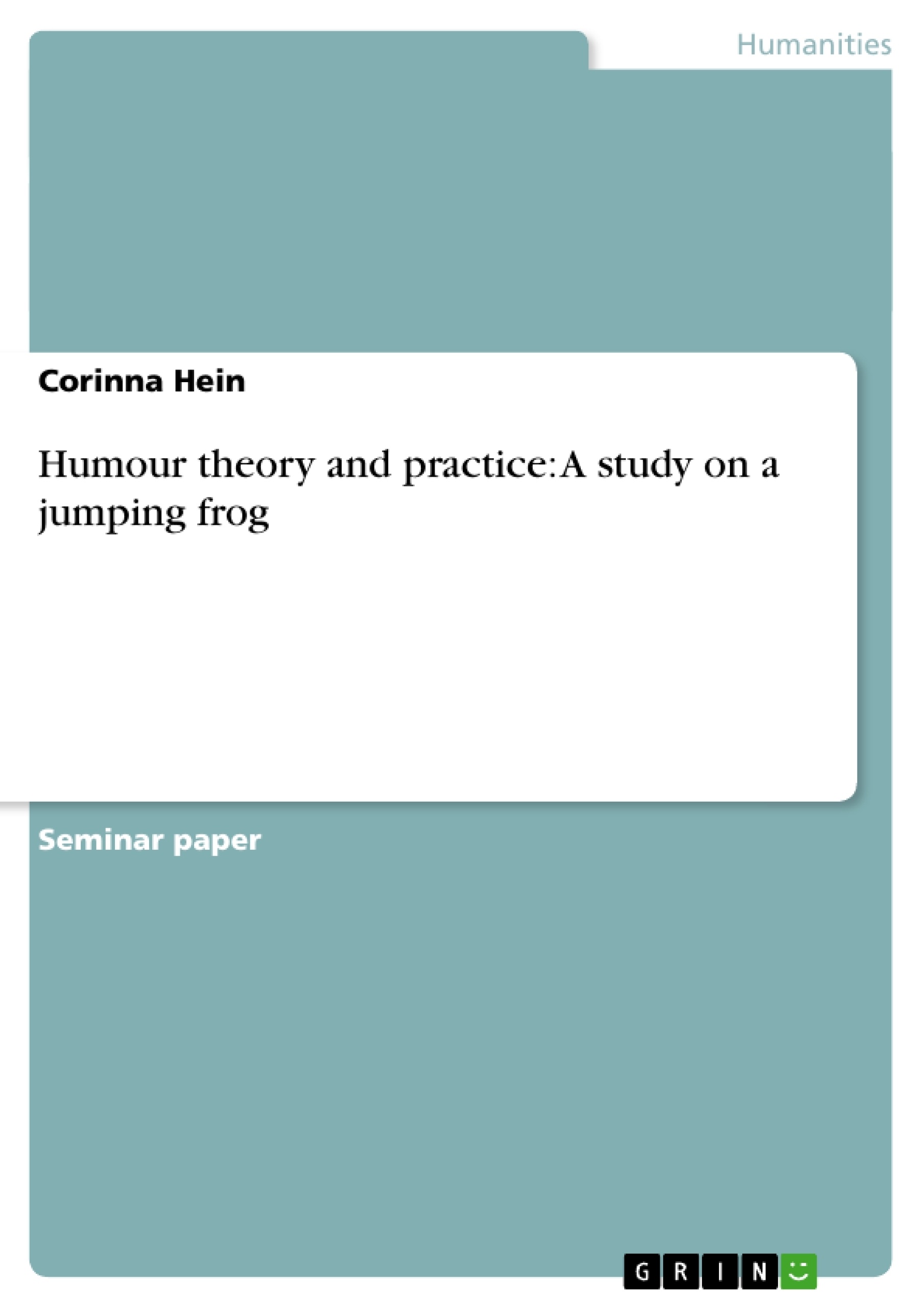Die vorliegende Abschlussarbeit arbeitet mit Bergsons und Freuds Theorien über den Humor, um Mark Twains humorvolle Erzählung "The Celebrated Jumping Frog of Calaveras County" zu analyisieren. Es wird offensichtlich, dass man Bergsons Theorie über die Komik, welche ihm zur Folge z.B. aus der Mechanisierung des Lebens resultiert, und auch Freuds Theorien unbewusste Mechanismen betreffend, in der Erzählung wieder findet.
Somit erweist sich der Humor der Erzählung als auf lustigen Stereotypisierungen, wie sie in den Figuren Smiley und Wheeler zu finden sind, basiert. Twain spielt mit Gefühlen von Überlegenheit, mit Erwartungen, Situationskomik, mit den Möglichkeiten, Lachen aufgrund von Mitleid zu erzeugen, mit Übertreibung, Wiederholung, Parallelismus, fehlender Übereinstimmung oder Satire.
Wie ebenfalls deutlich wird, bieten sich oft schon verschiedene Möglichkeiten der Interpretation dessen, was als “lustig” betrachtet wird, wenn man nur zwei Humortheoretiker zur Untersuchung heranzieht. Konsequenter Weise könnten moderne Humortheoretiker wahrscheinlich weitere Möglichkeiten der Interpretation aufzeigen. Das war nicht Ziel dieser Arbeit, würde jedoch zukünftig weiteren Analyseraum bieten.
Inhaltsverzeichnis (Table of Contents)
- Introduction
- Two Humour Theorists of the 20th Century and their Works
- Henry Bergson: Laughter: An Essay on the Meaning of the Comic
- Introducing Bergson
- How to Produce Comic
- How to Create a Comic Character
- Sigmund Freud: The Joke and his Relation to the Unconscious
- Introducing Freud
- "The Joke and his Relation to the Unconscious"
- Introduction
- Analytical Part
- Synthetic Part
- Theoretical Part
- Henry Bergson: Laughter: An Essay on the Meaning of the Comic
- A Study on a Jumping Frog
- Mark Twain
- The Celebrated Jumping Frog - Humour in Literature
- The Frame
- Summary
Zielsetzung und Themenschwerpunkte (Objectives and Key Themes)
This paper aims to examine Mark Twain’s short story “The Celebrated Jumping Frog of Calaveras Country” through the lenses of two influential 20th-century humor theorists: Henry Bergson and Sigmund Freud. By analyzing the story through their frameworks, the paper seeks to gain a deeper understanding of the comedic elements within the text.
- The evolution of humor theories in the 20th century, with a focus on Bergson and Freud.
- The application of Bergson's and Freud's theories to literary analysis, particularly in the context of comedic writing.
- The role of automatism and unconscious drives in generating humor.
- An exploration of Mark Twain's writing style and his contributions to American literature.
- The use of comedic devices in "The Celebrated Jumping Frog of Calaveras Country" to create humor.
Zusammenfassung der Kapitel (Chapter Summaries)
- Introduction: This chapter introduces the reader to the context of humor studies, highlighting the contributions of both Bergson and Freud. It also establishes the focus of the paper, which is the analysis of Mark Twain’s “The Celebrated Jumping Frog of Calaveras Country”.
- Two Humour Theorists of the 20th Century and their Works: This chapter provides an overview of the two main theorists whose work will be used to analyze Twain's story. It introduces both Henry Bergson and Sigmund Freud, discussing their backgrounds, key works, and major contributions to the field of humor studies. Specifically, Bergson's work on the "mechanical in the living" and Freud's exploration of the unconscious as a source of humor are discussed.
- A Study on a Jumping Frog: This chapter focuses on Mark Twain and his short story "The Celebrated Jumping Frog of Calaveras Country". It discusses the context of the story, including Twain’s life and times, and explores the comedic elements of the narrative. This chapter is likely to examine the story using the theoretical frameworks developed by Bergson and Freud.
Schlüsselwörter (Keywords)
This paper explores the nature of humor through the theoretical works of Bergson and Freud, applying their ideas to analyze a classic American short story, "The Celebrated Jumping Frog of Calaveras Country" by Mark Twain. Key concepts and terms that emerge include automatism, unconscious drives, comedic devices, and the relationship between humor and social context. The paper also delves into the historical context of American literature, exploring the influence of Twain and his contemporaries.
- Citation du texte
- Corinna Hein (Auteur), 2000, Humour theory and practice: A study on a jumping frog, Munich, GRIN Verlag, https://www.grin.com/document/24620



